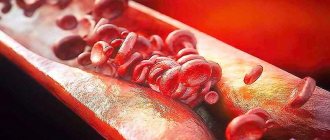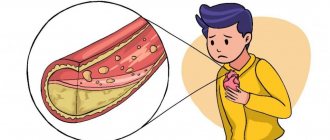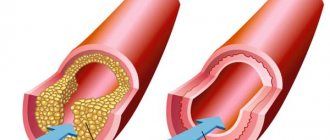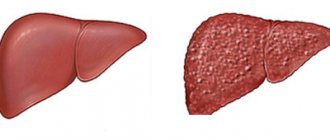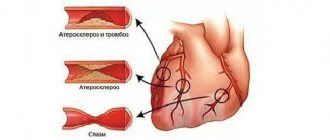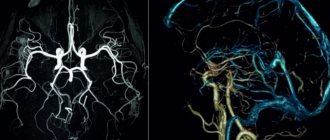Symptoms
Among the symptoms of cerebral atherosclerosis are:
- Certain signs of cerebral atherosclerosis include the following symptomatic picture:
- Sleep problems: insomnia, disturbing dreams, difficulty getting up and problems falling asleep again;
- Loss of sensation in half of the body;
- Severe, frequently recurring headaches;
- Increased cholesterol levels in blood tests:
- Changes in gait and loss of coordination;
- Changes in vision, flickering of “spots” before the eyes, tinnitus;
- Emotional changes: irritability, depression, tearfulness and anxiety;
- Hot flashes and sweating of the face;
- Increased fatigue, constant weakness and absent-mindedness;
- Trembling of the chin and limbs;
- Memory impairment, problems with short-term memory;
- The appearance of facial asymmetry. Source: L.S. Bizhanova. Ischemic brain disease // Bulletin of KazNMU, No. 2, 2015, pp. 241-242 Shabir O.
Clinical signs do not appear immediately. This happens long after cholesterol has begun to be deposited. Symptoms appear after the lumen of the arteries and capillaries of the brain narrows so much that 15% or more less blood begins to flow to the organs.
Signs of the disease depend on the stage:
1. In the first stages, the disease makes itself felt only after physical or emotional stress and quickly passes when the patient goes into a state of rest. The main symptom is asthenia, accompanied by fatigue, weakness, decreased alertness, and general lethargy. Rarely, sleep is disturbed, insomnia or daytime sleepiness occurs. Mostly, patients complain of headaches, tinnitus, and memory impairment. In the latter case, patients remember the past well, but do not remember new information well.
2. As the disease progresses, anxiety, suspiciousness, depression, and mood swings appear. Memory impairments become more pronounced, to the point that the patient does not remember what happened to him today. There is a constant headache and noise in the ears, speech is persistently impaired - it becomes unclear, diction changes, patients feel dizzy and have unsteady gait. Hearing and vision also deteriorate, limbs and head shake, and a person stops thinking logically and clearly.
3. At the last stage of atherosclerosis, dementia develops; the patient may behave like a child or become aggressive and tearful. Most people completely or partially lose their memory and cease to be interested in the world around them and the events in it. The ability to navigate in time and space is lost, the patient needs constant care because he loses self-care skills in everyday life. This stage is irreversible.
Diagnostics
A neurologist deals with this disease. First, the doctor collects anamnesis, interviews the patient about complaints, and conducts a series of tests. So, the following factors indicate the presence of the disease:
- The patient cannot look up;
- Reflexes are weakened or excessively increased, most often asymmetrically;
- In a standing position, legs together, arms extended forward, the patient cannot maintain balance;
- When the patient stretches his arms forward, his fingers tremble and become weak;
- Closing his eyes, a person cannot bring his finger to the tip of his nose.
These are indirect signs that only allow us to make an assumption about the presence of atherosclerosis. Therefore, a comprehensive examination is then carried out with consultations of other doctors - ENT, ophthalmologist, etc., depending on the existing disorders. At the medical office, you can get advice from related specialists on any disease, including in cases of suspected cerebral atherosclerosis. Source: Berwick J, Francis SE. Neurovascular dysfunction in vascular dementia, Alzheimer's and atherosclerosis // BMC Neurosci. 2021 Oct 17;19(1):62. doi:10.1186/s12868-018-0465-5.
In addition, it is necessary to undergo a biochemical analysis of the blood lipid spectrum (cholesterol, triglycerides, etc.)
List of instrumental studies:
- REG – radioencephalogram;
- Angiography of cerebral vessels;
- Duplex head scanning;
- Ultrasound Dopplerography of cerebral vessels;
- MRI of cerebral vessels;
- CT – computed tomography;
- EEG – electroencephalogram.
The diagnostic capabilities of a medical doctor allow you to accurately diagnose atherosclerosis, the extent of the disease and choose an effective treatment regimen.
What does the lymphatic system do?
The lymphatic system has been considered discovered since 1627 by the anatomist Gasparo Azelli, but Hippocrates first spoke about its individual parts in the 5th century. BC. It consists of lymphatic capillaries, vessels, nodes, lymphoid organs and covers each organ like the circulatory system.
The task of the lymphatic system is to drain and detoxify the pericellular space through the transport of interstitial fluid and the metabolic and breakdown products it contains, antigens and cytokines, immune cells and even lipoproteins.
The lymphatic system is actively involved in the body's immune response. It is in the lymphatic system that lymphocytes mature. It is the lymphatic system that absorbs fats from the small intestine that enter the body with food.
Since the beginning of the 19th century, data have been published that there are lymphatic capillaries in the walls of the artery, which cleanse it of metabolic products, but then no one was interested in this. Since the late 1980s, but especially active in the 2000s, with the active introduction of immunofluorescence imaging methods (markers such as LYVE-1, podoplanin, PROX1), research on the relationship between the lymphatic system and atherosclerosis has increased significantly, and everything has become to their places. Now no one doubts that the artery wall is indeed drained by the lymphatic network.
This means that the lymphatic network must also cleanse the wall of cholesterol plaque. In an experiment, this can be beautifully and demonstratively illustrated as follows. When lymphatic drainage is blocked in an experimental animal, atherosclerosis quickly begins to progress.
It was knowledge about the lymphatic system and its relationship with atherogenesis that formed the basis of our treatment technology.
Treating atherosclerosis
- Shishkin A.A.
- Volkov A.M.
- Kabirov A.V.
- Baranov V.S.
Shishkin Andrey Andreevich
Candidate of Medical Sciences. Surgeon, proctologist, phlebologist at SM-Clinic. Proficient in all modern methods of conservative and surgical treatment of diseases of the veins of the lower extremities (including sclerotherapy, EVLT - endovasal laser coagulation, traditional phlebectomy)
Read moreVolkov Anton Maksimovich
Phlebologist, surgeon at SM-Clinic. Performs operations with a modern proprietary method of treating varicose veins using a laser (modified endovenous laser coagulation. M-EVLC).
Surgical treatment of varicose veins of any complexity (phlebectomy, miniphlebectomy) More detailsKabirov Alexander Vitalievich
Cardiovascular surgeon at SM-Clinic. Candidate of Medical Sciences Proficient in all modern methods of conservative and surgical treatment of diseases of the veins of the lower extremities (including sclerotherapy, EVLT - endovasal laser coagulation, traditional phlebectomy)
More detailsBaranov Vladimir Sergeevich
Cardiovascular surgeon at SM-Clinic. Candidate of Medical Sciences Treats lower varicose veins using non-surgical and surgical methods (aesthetic sclerotherapy, ECHO sclerotherapy, stem sclerotherapy, phlebectomy, miniphlebectomy, EVLT).
More details
Symptomatic interventions:
- Sympathectomy
(intersection of the nerve plexuses responsible for spasm (narrowing) of the arteries) is performed for repeated blockages of the arteries and in addition to reconstructive operations. This operation improves blood circulation in the extremities by dilating small arteries. - Revascularization osteotomy
is also an adjuvant technique that improves blood circulation by stimulating the formation of new small vessels in the lower extremities after bone injury. - Arterialization of the venous bed
is rarely used at this time, since its implementation is associated with various technical difficulties, and long-term results are worse than the methods described above.
Treatment
The basis of treatment for this pathology is lifestyle adjustments. This means:
- lipid-restricted diet,
- rejection of bad habits,
- physical activity regimen,
- avoiding stress,
- treatment of chronic diseases.
The focus of drug therapy is the use of lipid-lowering drugs, antiplatelet, antihypertensive and antioxidant drugs, drugs to improve microcirculation and symptomatic therapy. Therapy, as a rule, takes a very long time and depends on the stage at which it was started.
In case of severe stenotic processes, surgical treatment is recommended for the patient. Most often, surgical intervention is performed on the internal carotid arteries. Source: E.A. Shirokov. Stenosing atherosclerosis of the cerebral arteries: modern strategies for diagnosing and treating patients // Consilium Medicum, vol. 18, no. 9, 2021, pp. 37-42.
Treatment for this disease is aimed at ensuring that metabolic processes are restored, and harmful cholesterol no longer settles on the walls of blood vessels. At the same time, attention is also paid to restoring blood circulation and normalizing the nutrition of brain tissue.
Drug therapy
This is the most important part of the comprehensive treatment of atherosclerosis. Patients may be prescribed several groups of medications:
- Statins - reduce the size of cholesterol plaques, reduce the risk of narrowing of the main arteries of the brain, and stop the growth of plaques.
- Antiplatelet agents – reduce blood viscosity and prevent blood clots.
- Fibrates are similar in action to statins, but do not affect the size of plaques, but lower the triglyceride content in the blood.
- Means for restoring vascular function.
- Bile acid sequestrants prevent cholesterol from being absorbed from food.
- Nootropics and medications that improve metabolic processes in nervous tissue.
- Hypotensives that stabilize blood pressure and help prevent stroke.
- Vitamin and mineral complexes to improve the general condition of the body. They must contain vitamins A, C, group B and nicotinic acid.
Medicines are taken in long courses, and most of them are taken for life with periodic dosage adjustments.
Surgical treatment
Operation is a last resort, indications for it:
- narrowing of the lumen of the carotid artery by 70% or more;
- condition after a minor stroke;
- recurrent ischemic attacks.
Surgical options:
- bypass - the formation of a vessel bypassing the one affected by cholesterol deposits;
- endarterectomy - a procedure to remove cholesterol plaques along with a small amount of tissue that lines the vessel from the inside;
- stenting using endoscopic technology - an expanding structure impregnated with a composition that dissolves cholesterol is installed in the vessel.
Operations can be performed under general anesthesia or local anesthesia. An anesthesiologist is consulted before the operation. The length of hospital stay varies depending on the technique, as do recommendations for the recovery period. SM-Clinic doctors inform patients in detail about all the nuances and are ready to answer any questions related to treatment at the initial consultation. Consultation on the operation is free of charge.
You can find out more about discounts on preoperative examinations by following the link.
Causes
Atherosclerosis of the heart arteries develops under the influence of both social and physiological factors. In cardiology, there are more than 200 reasons that provoke the progression of pathology. The most common are:
- Lipid metabolism disorders, as a result of which excess cholesterol accumulates in the body, settling on the walls of blood vessels;
- Smoking has an extremely negative effect on the cardiac system. Nicotine and heavy tars damage cell membranes in blood vessels. Permeability is impaired, blood circulation worsens;
- Hypertonic disease. High blood pressure increases the load on the heart muscle;
- Static lifestyle. Office work, lack of normal activity leads to a slowdown in metabolic processes, stagnant processes begin to develop;
- Unbalanced diet. Eating large amounts of fried, fatty foods leads to pathologies of the circulatory system;
- Genetic predisposition. If at least one close blood relative has been diagnosed with atherosclerosis of the heart vessels, then the risk of developing the disease increases several times;
- Floor. In young and middle-aged women, the development of atherosclerosis is prevented by natural processes in the body - the synthesis of estrogens. After menopause, the risk of pathology increases;
- Elderly age. The gradual accumulation of harmful fats occurs over decades. Therefore, the older a person becomes, the greater the likelihood of a dangerous diagnosis;
- Drug addiction diseases. The presence of alcohol or drug addiction aggravates a person’s general health; one of the complications of addiction can be atherosclerosis of the coronary arteries of the heart;
Diabetes. The clinical picture of the disease includes multiple lesions of blood vessels, against the background of impaired metabolism. Atherosclerosis can be a complication.
Diet
Changing your diet is also a way to improve your well-being and is a great help for other treatment methods. Atherosclerosis very often progresses precisely against the background of poor nutrition and lifestyle, so it is necessary
- follow a certain diet:
- reduce consumption of red and fatty meats and meat in general;
- limit the consumption of confectionery products and baked goods;
- eat as few egg yolks as possible;
- limit solid vegetable fats – margarine – in the diet;
- completely eliminate alcohol, sausages, fast food, and canned food.
Recommended products include vegetables (fresh, pickled, dried), cereals (rice, buckwheat, barley, millet, oats, flax, etc.), dried, fresh and dried fruits, turkey and chicken fillets, river and sea fish.
You need to eat at least 5 times a day at the same time in small portions. It is necessary to avoid fried foods and prepare food using the methods of boiling, steaming, stewing, and baking.
Possible risks associated with atherosclerosis
The most dangerous complication is a stroke. If at the same time the patient has poor eating habits, is overweight, moves little and is regularly exposed to stress, then with an 80% probability he will become disabled as a result, unable to care for himself. The mortality rate is also high.
Prevention
To prevent cerebral atherosclerosis, you need to avoid smoking, follow a diet, and keep yourself in good shape with moderate physical activity. It is very important to establish a psycho-emotional background, protect yourself from stress, and if this is not possible, then take courses of sedatives and amino acids, for example Glycine.
| Name of service (price list incomplete) | Price, rub.) | In installments* |
| Appointment (examination, consultation) with a cardiovascular surgeon, primary, therapeutic and diagnostic, outpatient | 1 750 | — |
| Program “Risk of atherosclerosis and ischemic heart disease, predisposition to dyslipidemia” | 19 000 | — |
* You can read more about the conditions here - Treatment on credit or in installments.
Bibliography
When compiling this article, we deliberately simplify some of the material so that it is understandable for non-specialists. If you are a doctor, we will be happy to answer your questions. Write or call us to discuss details. To prepare this material, the following publications were used:
- Girard JP, Moussion C., Forster R. HEVs, lymphatics and homeostatic immune cell trafficking in lymph nodes. Nat. Rev. Immunol. 2012;12:762–773. doi: 10.1038/nri3298.
- Randolph GJ, Miller NE Lymphatic transport of high-density lipoproteins and chylomicrons. J. Clin. Investig. 2014;124:929–935. doi:10.1172/JCI71610.
- Aspelund A., Robciuc MR, Karaman S., Makinen T., Alitalo K. Lymphatic System in Cardiovascular Medicine. Circ. Res. 2016;118:515–530. doi: 10.1161/CIRCRESAHA.115.306544.
- Alitalo K., Tammela T., Petrova TV Lymphangiogenesis in development and human disease. Nature. 2005;438:946–953. doi: 10.1038/nature04480.
- Moore KJ, Sheedy FJ, Fisher EA Macrophages in atherosclerosis: A dynamic balance. Nat. Rev. Immunol. 2013;13:709–721. doi: 10.1038/nri3520.
- Rademakers T., van der Vorst EP, Daissormont IT, Otten JJ, Theodorou K., Theelen TL, Gijbels M., Anisimov A., Nurmi H., Lindeman JH, et al. Adventitial lymphatic capillary expansion impacts on plaque T cell accumulation in atherosclerosis. Sci. Rep. 2017;7:45263. doi: 10.1038/srep45263.
- Milasan A., Ledoux J., Martel C. Lymphatic network in atherosclerosis: The underestimated pathway. Future Sci. O.A. 2015;1:FSO61. doi: 10.4155/fso.15.61.
- Camare C., Pucelle M., Negre-Salvayre A., Salvayre R. Angiogenesis in the atherosclerotic plaque. Redox. Biol. 2017;12:18–34. doi: 10.1016/j.redox.2017.01.007.
- Randolph GJ Mechanisms that regulate macrophage burden in atherosclerosis. Circ. Res. 2014;114:1757–1771. doi: 10.1161/CIRCRESAHA.114.301174
- Johnson RA Lymphatics of blood vessels. Lymphology. 1969;2:44–56.
- Drozdz K., Janczak D., Dziegiel P., Podhorska M., Patrzalek D., Ziolkowski P., Andrzejak R., Szuba A. Adventitial lymphatics of internal carotid artery in healthy and atherosclerotic vessels. Folia Histochem. Cytobiol. 2008;46:433–436. doi: 10.2478/v10042-008-0083-7.
- Kutkut I., Meens MJ, McKee TA, Bochaton-Piallat ML, Kwak BR Lymphatic vessels: An emerging actor in atherosclerotic plaque development. Eur. J. Clin Investig. 2015;45:100–108. doi: 10.1111/eci.12372
- Xu X., Lin H., Lv H., Zhang M., Zhang Y. Adventitial lymphatic vessels—An important role in atherosclerosis. Med. Hypotheses. 2007;69:1238–1241. doi: 10.1016/j.mehy.2007.04.007.
- Martel C., Randolph GJ Atherosclerosis and transit of HDL through the lymphatic vasculature. Curr. Atheroscler. Rep. 2013;15:354. doi:10.1007/s11883-013-0354-4.
- Huang LH, Elvington A., Randolph GJ The role of the lymphatic system in cholesterol transport. Front. Pharmacol. 2015;6:182. doi: 10.3389/fphar.2015.00182.
- Csányi G, Singla B. Arterial Lymphatics in Atherosclerosis: Old Questions, New Insights, and Remaining Challenges. J Clin Med. 2019;8(4):495. Published 2021 Apr 11. doi:10.3390/jcm8040495
- Levin Yu.M. Fundamentals of therapeutic lymphology. - M.: Medicine, 1986. - 288 p., ill.
